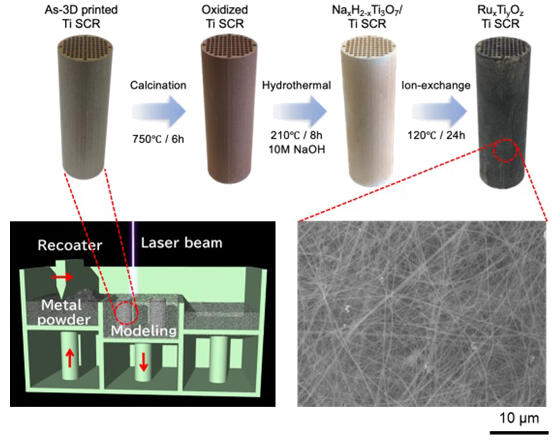A research group led by Specially Appointed Assistant Professor Hyo-Jin Kim, Professor Kohsuke Mori, Professor Takayoshi Nakano, and Professor Emeritus Hiromi Yamashita from the Graduate School of Engineering at the University of Osaka, and Specially Appointed Professor Satoshi Ichikawa from the Research Center for Ultra-High Voltage Electron Microscopy at the University of Osaka has successfully created a metal self-catalytic reactor that can convert carbon dioxide (CO2), a greenhouse gas, into methane (CH4), the main component of city gas, with nearly 100% selectivity by combining laser metal 3D printing technology with surface treatment. The group's findings were published in Nature Communications.

Provided by the University of Osaka
While conventional ruthenium (Ru) catalysts require pressurization to 20 atmospheres to achieve comparable activity, the new catalyst exhibits exceptional characteristics with high activity and selectivity at low temperatures of 140℃ under just 1 atmosphere of pressure. Furthermore, detailed investigation of the microstructure of the highly active Ru active species provided evidence for a theory that negatively charged (Ti3O7)2− layers promote the formation and stabilization of isolated Run+ species in a low oxidation state (0<n<4), enabling CO2 activation under mild atmospheric pressure conditions. This breakthrough is expected to have significant ripple effects not only in the catalyst field oriented toward carbon neutrality but also in the advanced material science field based on metal 3D printing technology.
Mori commented: "As we work toward achieving carbon neutrality by 2050, innovations in catalyst technology contributing to CO2 reduction are underway, with the development of practical catalysts for methanation recognized as an important challenge. The application of the metal 3D printing technology used in this research is still developing in the catalyst materials field, but when combined with surface treatment methods, it can target a wide variety of metal materials, making it a potential foundational technology for future industrial development. At the same time, we have succeeded in elucidating the catalytic factors driving low-temperature activity, leading to academically important findings. Therefore, we hope this research will interest both industrial and academic researchers."
Journal Information
Publication: Nature Communications
Title: Layered Na2Ti3O7-supported Ru catalyst for ambient CO2 methanation
DOI: 10.1038/s41467-025-57954-9
This article has been translated by JST with permission from The Science News Ltd. (https://sci-news.co.jp/). Unauthorized reproduction of the article and photographs is prohibited.




